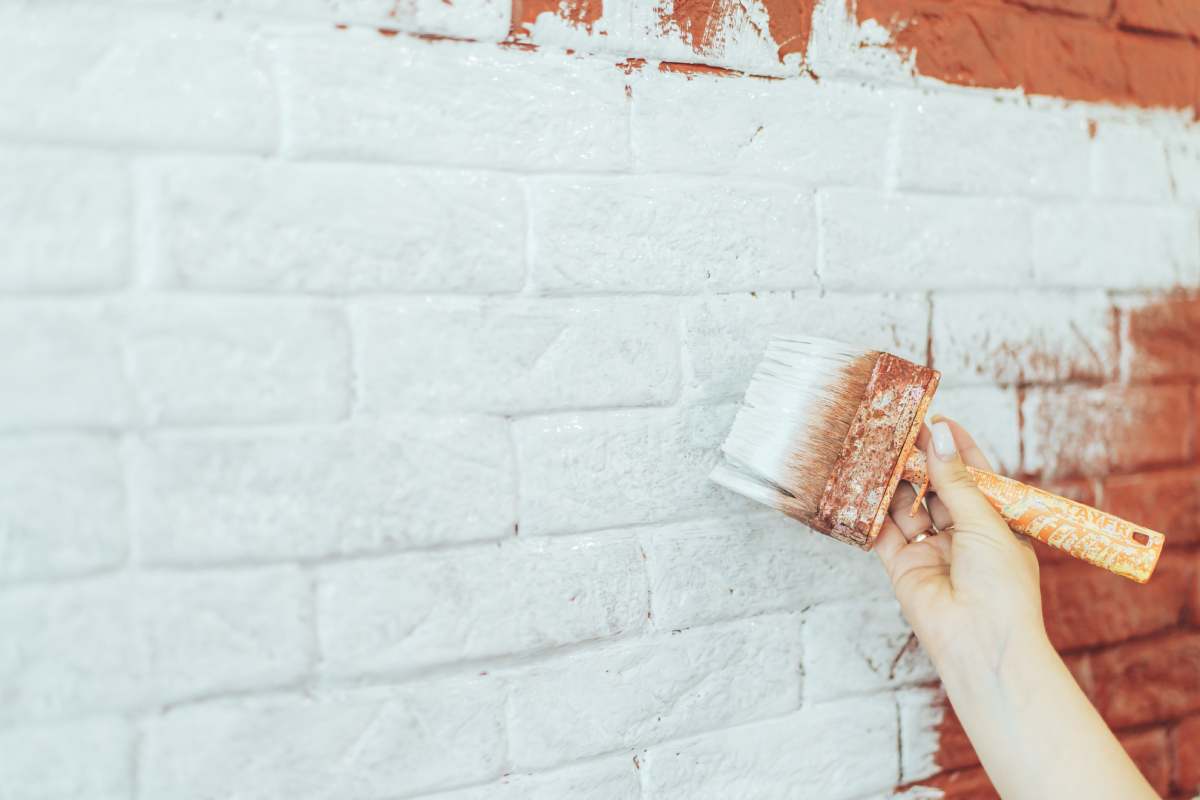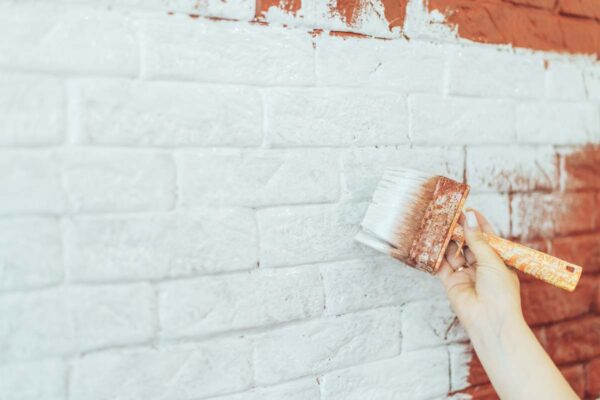Painting your walls is a satisfying way to upgrade your home, but it’s incredibly annoying when the paint refuses to stick. Paint adhesion can be influenced by many things, like dirty surfaces or the weather. Humidity, in particular, is a big deal because it can make or break your paint job.
Getting why paint might not stick and knowing how to get it to adhere better, especially when it’s humid, is key to getting that perfect, enduring result.
Read more:
- Can you paint directly over brick? How do you prepare a brick house for painting? How long will paint last on a brick house?
- Checklist Inspection Before Buying a House
Why Is My Wall Paint Not Sticking?
When your wall paint isn’t sticking, it can be frustrating and disappointing, especially after investing time and effort into painting your space. There are several common reasons why this issue might occur. Understanding these causes can help you achieve a smooth, long-lasting paint finish.
1. Surface Contamination
One of the most common reasons for paint not adhering to walls is surface contamination. Dust, dirt, grease, and other residues can prevent paint from sticking properly. Before painting, it’s essential to clean the walls thoroughly. Use a mild detergent and water to remove any grime, then rinse and let the walls dry completely. In some cases, especially in kitchens, you might need a stronger cleaner to cut through grease.
2. Moisture Issues
Moisture is a significant enemy of paint adhesion. If your walls are damp, the paint won’t stick properly. This problem is common in bathrooms, basements, and areas with high humidity. Ensure your walls are dry before painting. Use a dehumidifier if necessary, and consider applying a moisture barrier or primer designed for damp conditions.
3. Inadequate Surface Preparation
Proper surface preparation is crucial for paint adhesion. If the surface is not adequately prepared, the paint won’t bond well. This includes sanding rough or glossy surfaces to create a texture that the paint can grip. Also, filling in any holes or cracks with a suitable filler and sanding smooth before painting is essential. Priming the surface is another critical step, especially if you’re painting over a dark color or a glossy finish.
4. Old or Poor-Quality Paint
Using old or poor-quality paint can lead to adhesion problems. Old paint may not adhere well due to changes in its composition over time. Similarly, low-quality paints often lack the binding agents necessary for good adhesion. Investing in high-quality paint can make a significant difference in the longevity and appearance of your painted walls.
5. Temperature and Humidity Conditions
The environment in which you paint also plays a vital role. Extreme temperatures and high humidity can affect how well the paint adheres to the wall. Ideally, you should paint when the temperature is between 10°C and 30°C (50°F and 85°F) and the humidity is low. Avoid painting on very hot or cold days, or when the humidity is high, as this can cause the paint to dry improperly and not stick well.
6. Incorrect Application Techniques
The way you apply the paint can impact its adhesion. Applying paint too thinly or too thickly can cause problems. For example, if the paint is too thin, it might not cover well, while overly thick paint can crack and peel. Using the right type of brush or roller and applying the paint evenly in thin, consistent layers will help ensure better adhesion. Allow adequate drying time between coats according to the manufacturer’s instructions.
7. Underlying Coatings
Previous layers of paint or coatings on the wall can also affect adhesion. If the underlying paint is in poor condition, peeling, or flaking, the new paint won’t stick well. In such cases, it’s necessary to remove the old, loose paint before applying a new coat. This can be done by scraping, sanding, or using a paint remover, depending on the extent of the damage.
How to Improve Paint Adhesion
Ensuring that paint sticks well to your walls is crucial for a durable and visually appealing finish. Here are some practical steps to improve paint adhesion and achieve professional-looking results.
1. Thorough Cleaning
Before painting, clean your walls to remove dust, dirt, grease, and other contaminants that can prevent paint from sticking. Use a mild detergent mixed with water for general cleaning. In kitchens and areas prone to grease buildup, consider using a degreaser. Rinse the walls with clean water and let them dry completely before proceeding.
2. Repair and Smooth the Surface
Inspect your walls for any cracks, holes, or imperfections. Use a filler or spackling compound to repair these areas. Once the filler is dry, sand the surface to create a smooth, even base. This step is crucial because a smooth surface ensures better paint adhesion and a more uniform finish.
3. Sand Glossy Surfaces
If your walls have a glossy or semi-glossy finish, sand them lightly to create a rough texture. This gives the new paint something to grip onto. Use fine-grit sandpaper and sand in a circular motion. After sanding, wipe the walls with a damp cloth to remove any dust.
4. Use a Quality Primer
Priming is a vital step in improving paint adhesion. A primer creates a uniform surface and helps the paint adhere better. Choose a primer suitable for your specific surface and paint type. For problematic surfaces, such as those with stains or uneven textures, consider using a high-adhesion primer.
5. Control Environmental Conditions
Paint adhesion is affected by the temperature and humidity in your painting environment. For best results, paint when the temperature is between 10°C and 30°C (50°F and 85°F) and the humidity is low. Avoid painting on very hot, cold, or humid days, as these conditions can affect how the paint dries and adheres to the wall.
6. Choose High-Quality Paint
Investing in high-quality paint can make a significant difference in adhesion and the overall finish. Quality paints contain better binding agents, which help the paint stick to the surface more effectively. Read reviews and consult with professionals to choose the best paint for your project.
7. Apply Paint Correctly
Proper application techniques are essential for good paint adhesion. Here are some tips:
- Use the Right Tools: Select high-quality brushes and rollers suitable for your paint type. A good brush or roller will apply paint more evenly and effectively.
- Thin, Even Coats: Apply the paint in thin, even layers. Thick coats can cause the paint to crack and peel. Allow each coat to dry completely before applying the next one.
- Follow Manufacturer Instructions: Adhere to the drying and recoating times specified by the paint manufacturer. Rushing the process can lead to poor adhesion and an uneven finish.
8. Address Underlying Paint Issues
If the existing paint on your walls is peeling or flaking, it needs to be removed before applying a new coat. Scrape off loose paint and sand the edges to smooth the surface. This step prevents the new paint from peeling off along with the old paint.
How Humidity Affects Paint Adhesion
Humidity plays a crucial role in the painting process and can significantly impact paint adhesion. Understanding how humidity affects paint adhesion can help you achieve better results and avoid common issues.
1. Slower Drying Time
High humidity levels mean there is more moisture in the air. When you paint in a humid environment, the water in the paint takes longer to evaporate. This extended drying time can cause several problems:
- Tacky Surface: The paint may remain tacky for longer periods, making it more susceptible to dust and debris sticking to it.
- Uneven Finish: Slow drying can result in an uneven finish as some areas may dry faster than others.
2. Poor Adhesion
When paint dries too slowly due to high humidity, it may not adhere properly to the surface. This can lead to several issues:
- Peeling and Blistering: The paint might peel or blister because it hasn’t bonded correctly to the wall.
- Mildew Growth: High humidity can promote mildew growth on the painted surface, especially if the walls were not completely dry before painting.
3. Compromised Durability
Paint that doesn’t adhere well will not be as durable. This can result in:
- Reduced Lifespan: The paint may start to show signs of wear and tear sooner, requiring more frequent repainting.
- Poor Resistance: The paint might not resist moisture and stains effectively, leading to discolouration and damage.
Ideal Humidity Conditions for Painting
For optimal paint adhesion, it’s best to paint when the humidity is low. The ideal relative humidity for painting is between 40% and 60%. Here are some tips for managing humidity during your painting project:
- Check Weather Forecasts: Choose a time to paint when the weather forecast predicts low humidity levels.
- Use a Dehumidifier: In areas where humidity is consistently high, using a dehumidifier can help create a better environment for painting.
- Ventilate the Area: Ensure good ventilation by opening windows and using fans to circulate air, helping the paint to dry more quickly and evenly.
Steps to Improve Paint Adhesion in Humid Conditions
If you must paint in a humid environment, follow these steps to improve paint adhesion:
- Prep the Surface Thoroughly: Clean the walls to remove any dust, grease, or mildew. Ensure the walls are completely dry before starting to paint.
- Use a High-Quality Primer: A good primer can create a better bonding surface for the paint, especially in challenging conditions.
- Choose the Right Paint: Some paints are formulated to perform better in high humidity. Look for paints labelled as moisture-resistant or suitable for humid conditions.
- Apply Thin Coats: Apply paint in thin, even layers. Thinner coats dry more quickly and evenly, reducing the risk of poor adhesion.
- Allow Extra Drying Time: Be patient and allow extra drying time between coats. Follow the manufacturer’s recommendations for drying times, but be prepared to extend these times in humid conditions.
In Conclusion
Getting the paint to stick well requires careful prep and considering a bunch of factors, especially humidity. When it’s super humid, the paint takes longer to dry and might not stick properly, leading to peeling, blistering, and weaker durability.
But don’t worry! If you clean and fix up the surfaces really well, use good primers and paints, and control the painting environment, you can get the paint to stick a whole lot better. With the right approach, you can make sure your paint job not only looks awesome but also lasts a long time, even in tough conditions. Understanding and dealing with the impact of humidity and other factors will help you get a pro-looking, long-lasting finish for your walls.







